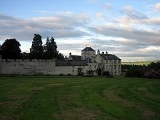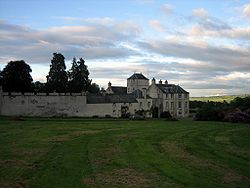
Foulis Castle
Encyclopedia

Kiltearn
Kiltearn is a parish in Ross and Cromarty, Scotland. The principal settlement is the village of Evanton, and the parish extends almost to Dingwall and about halfway to Alness. The old Kiltearn church and burial ground are on the shore of the Cromarty Firth. The current church is on the main...
, about 1.5 miles southwest of the village of Evanton
Evanton
Evanton is a large village in Easter Ross, in the Highland Council Area of Scotland. It lies between the river Sgitheach and the Allt Graad, is north of the city of Inverness, some south-west of Alness, and north-east of Dingwall. The village has a dozen or so streets, the main one being...
in the Highland
Highland (council area)
Highland is a council area in the Scottish Highlands and is the largest local government area in both Scotland and the United Kingdom as a whole. It shares borders with the council areas of Moray, Aberdeenshire, Perth and Kinross, and Argyll and Bute. Their councils, and those of Angus and...
area of northern Scotland
Scotland
Scotland is a country that is part of the United Kingdom. Occupying the northern third of the island of Great Britain, it shares a border with England to the south and is bounded by the North Sea to the east, the Atlantic Ocean to the north and west, and the North Channel and Irish Sea to the...
. The castle has been the seat of the Clan Munro
Clan Munro
-Origins:The main traditional origin of the clan is that the Munros came from Ireland and settled in Scotland in the 11th century and that they fought as mercenary soldiers under the Earl of Ross who defeated Viking invaders in Rosshire...
for over eight hundred years. During the 11th century, the clan chief was given the castle and Foulis lands as a reward from the Earl of Ross
Earl of Ross
The Mormaer or Earl of Ross was the leader of a medieval Gaelic lordship in northern Scotland, roughly between the River Oykel and the River Beauly.-Origins and transfers:...
for defeating Viking
Viking
The term Viking is customarily used to refer to the Norse explorers, warriors, merchants, and pirates who raided, traded, explored and settled in wide areas of Europe, Asia and the North Atlantic islands from the late 8th to the mid-11th century.These Norsemen used their famed longships to...
invaders. The remains of an 11th-century Motte
Motte-and-bailey
A motte-and-bailey is a form of castle, with a wooden or stone keep situated on a raised earthwork called a motte, accompanied by an enclosed courtyard, or bailey, surrounded by a protective ditch and palisade...
(man-made mound topped by a wooden palisade), believed to be the very first fortification at Foulis, still remain in the castle grounds today.
Early history
Foulis Castle itself is mentioned briefly in records that date back to the 14th century although the original Tower of Foulis was believed to have been built in 1154. It is recorded by contemporary evidence that Uilleam III, Earl of RossUilleam III, Earl of Ross
Uilleam III of Ross was the fourth successor of Ferchar mac in tSagairt, as Mormaer of Ross .Uilleam came into his inheritance at a torrid time, his father Aodh dying at the Battle of Halidon Hill. Uilleam temporarily lost many of his lands. However, he returned from Norway in 1336 and regained them...
granted a charter to Robert de Munro of Foulis for the lands of "Estirfowlys" with the "Tower of Strathskehech" from 1350. It is also recorded that Euphemia I, Countess of Ross
Euphemia I, Countess of Ross
Euphemia I , also called Euphemia of Ross and Euphemia Ross, and sometimes incorrectly styled Euphemia Leslie and Euphemia Stewart , was a Countess of Ross in her own right.Euphemia was the elder daughter of Uilleam III, Mormaer of Ross...
granted two charters to Robert's son, Hugh Munro, 9th Baron of Foulis
Hugh Munro, 9th Baron of Foulis
Hugh Munro, 9th Baron of Foulis was a 14th - 15th century Scottish soldier and said to be 12th chief of the Clan Munro in the Scottish Highlands. Hugh was seated at Foulis Castle in Ross-shire, Scotland...
in 1394. One of them dated 4 May 1394 is in respect of the "Wesstir Fowlys" and the "Tower of Strathschech", named so because of the River Sgitheach
River Sgitheach
River Sgitheach also known as Skiach or Skiack, is a river in Ross and Cromarty, Scotland...
that passes through nearby Strath Skiach and into the Cromarty Firth
Cromarty Firth
The Cromarty Firth of Cromarty') is an arm of the North Sea in Scotland. It is the middle of the three sea lochs at the head of the Moray Firth: to the north lies the Dornoch Firth, and to the south the Beauly Firth....
.
A document signed and sealed at Foulis Castle in 1491 reads in Gaelic "caisteal biorach, nead na h-iolair", which means "castle gaunt-peaked, the eagle's nest".This is in allusion to the clan chief's hereldic emblem.
In 1542 Donald Mackay of Strathnaver, chief of the Clan Mackay
Clan MacKay
Clan Mackay is an ancient and once powerful Scottish clan from the far north of the Scottish Highlands, but with roots in the old kingdom of Moray. They were a powerful force in politics beginning in the 14th century, supporting Robert the Bruce. In the centuries that followed they were...
was imprisoned in Foulis Castle, when he was captured after the Battle of Alltan-Beath
Battle of Alltan-Beath
The Battle of Alltan-Beath also known as the Battle of Ailtan-Beath was a Scottish clan battle said to have taken place in the year 1542 in the village of Knockarthur , in Sutherland, in the Scottish Highlands...
. The castles "tower and fortalice" are also mentioned in a charter from the crown in 1587. In times of clan warfare, a signal beacon was lit on the highest tower of Foulis Castle to gather the clan under arms, hence the Munro slogan or gathering cry of "Caisteal Foghlais na theine," meaning Castle Foulis ablaze.
The castle survived up to the 18th century until it was attacked by Jacobites
Jacobitism
Jacobitism was the political movement in Britain dedicated to the restoration of the Stuart kings to the thrones of England, Scotland, later the Kingdom of Great Britain, and the Kingdom of Ireland...
in 1746. The Clan Munro had been away on duty for the Government under the command of the chief's brother George Munro, 1st of Culcairn. Chief Sir Robert Munro, 6th Baronet was commanding an English regiment at the Battle of Falkirk (1746)
Battle of Falkirk (1746)
During the Second Jacobite Rising, the Battle of Falkirk Muir was the last noteworthy Jacobite success.-Background:...
with his brother Dr Duncan Munro where they were both killed. After which Foulis Castle was burned by the Jacobites.
Robert's son the next successive chief, Sir Harry Munro, 7th Baronet returned home from captivity to find the castle had been set on fire and much of the castle had been destroyed. The Jacobites were defeated just a few months later by Government forces at the Battle of Culloden
Battle of Culloden
The Battle of Culloden was the final confrontation of the 1745 Jacobite Rising. Taking place on 16 April 1746, the battle pitted the Jacobite forces of Charles Edward Stuart against an army commanded by William Augustus, Duke of Cumberland, loyal to the British government...
. Chief Sir Harry Munro set about rebuilding the castle incorporating what he could of the original building. However as the Battle of Culloden had brought a complete end to the Highland clan system there was no need for such a defensive fort anymore. As with many castles at this time it was re-built as a large mansion house as we see it today.
Restoration
Unfortunately no records survive of what the fortifications at Castle Foulis looked like before 1746. However much has been learned about the castle and what the fortifications might have looked before 1746 by Captain and Mrs. Munro in their various stages of restoration. They believe that it was probably surrounded by a series of smaller dwellings, of possibly a fortified nature. They found in 1957–59, much evidence to suggest that in the courtyard area horses and cattle were kept, and that it was a self-contained community able to withstand a siege, when attacked.Certainly the foundations of the Castle are of mammoth proportions, as has been found by the late Chief during the three stages of restoration that he and his wife have carried out — in 1957–59, 1977–79, and most recently, in 1985–86. The Tower was obviously a "fortification", as its walls at the ground level are a massive five feet six inches thick. In May 1985, while repairs were being carried out in part to the Courtyard building, an interesting discovery was made. Four "cannon loops of an inverted key hole type," dating from the early part of the 16th century, were discovered behind four wedge-shaped, blocked-up apertures facing north, south, east and west in a five-foot-, six-inch-thick wall. Above them is a barrel-vaulted stone ceiling.
This building, at one time separate from the Castle, had certainly been constructed as a small defensive fort with an all-round "field of fire" to guard against possible attack.
At some later date, perhaps after 1746 and when the Chief felt that the chances of attack had lessened, the use of this building had changed. Three of the apertures had been completely blocked while the fourth had been partially blocked, leaving a narrow slit six inches wide and three feet long, into which a three-quarter-inch iron bar was strongly built, giving light, some air and access through which food could be passed to the unfortunate prisoner. It was likely the castle's gaol. According to Munro sources, some of the stone wall of the original castle was found under the plaster of the current main mansion house building at Foulis.
Foulis Castle is not to be confused with Fowlis Castle, a completely different, and much smaller, fortified house in the village of Fowlis Easter, near Dundee
Dundee
Dundee is the fourth-largest city in Scotland and the 39th most populous settlement in the United Kingdom. It lies within the eastern central Lowlands on the north bank of the Firth of Tay, which feeds into the North Sea...
. The coincidence in name is doubtless to be attributed to both castles being derived from Gaelic - foghlais, 'streamlet'.

